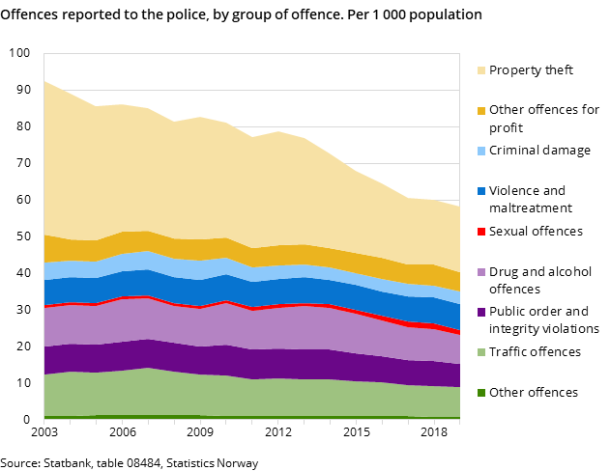Drop in offences without victims
Published:
In 2019, a total of 310 000 offences were registered by the police and prosecution authority, which is 2.5 per cent less than the year before. The decrease is related to an extended drop in narcotic offences and other offences without registered victims.
- Full set of figures
- Offences and victims reported to the police
- Series archive
- Offences and victims reported to the police (archive)
Following continual record low levels of reported offences in recent years, for the most part driven by the big decline in theft during 2012-2017, 2019 saw a small increase in reported thefts. However, from 2015 – partly overlapping the last years of theft decline – there has been a significant drop in control dependent offences without registered victims.
In order to be discovered and reported, certain types of offences all but depend on the control activities of the police and other agencies. This especially applies to drug and alcohol offences, traffic violations and many types of public order and integrity violations. In total, offences without registered victims accounted for three parts of the overall drop in offences reported in 2019, according to new figures from the statistics on Offences and victims reported to the police.
In 2019, the police reports included 41 900 drug and alcohol offences and 43 200 traffic misdemeanours, which is 8.5 and almost 4 per cent less than the year before respectively. The 34 300 public order and integrity violations made up a 5.5 per cent decrease from 2018. These control dependent groups of offences has seen a combined drop of more than 17 per cent since 2015, with nearly the whole drop being amongst offences without registered vicitms.
Lowest number of narcotic offences since the ‘90s
In 2019, 28 800 narcotic offences were reported to the police, of which 13 400 were violations of the penal code and 15 400 were about use and possession of narcotics in violation of the Act relating to medicinal goods. This equals a combined drop of 9 per cent from the year before, and as much as 39 per cent less than the peak year 2013 – as shown in figure 2. In fact, in order to find a year with fewer narcotic offences reported than in 2019, we have to go as far back as the 1990’s.
Figure 2. Offences repored to the police, by type of narcotic offence. 1999-2019. Per 1 000 population
| Posession of narcotics, Act relating to medical goods etc. | Use of narcotics, Act relating to medical goods etc. | Narcotic offence, Penal Code | Aggravated narcotic offence, Penal Code | |
| 1999 | 1.8 | 2.7 | 3.4 | 0.2 |
| 2000 | 2.0 | 2.8 | 3.7 | 0.2 |
| 2001 | 2.3 | 3.2 | 4.2 | 0.2 |
| 2002 | 2.4 | 3.0 | 4.0 | 0.3 |
| 2003 | 1.9 | 2.3 | 3.3 | 0.3 |
| 2004 | 1.8 | 2.4 | 3.4 | 0.2 |
| 2005 | 1.8 | 2.4 | 3.5 | 0.2 |
| 2006 | 1.9 | 2.7 | 3.9 | 0.3 |
| 2007 | 1.6 | 2.7 | 3.8 | 0.3 |
| 2008 | 1.5 | 2.4 | 3.5 | 0.2 |
| 2009 | 1.5 | 2.5 | 3.7 | 0.2 |
| 2010 | 1.7 | 2.8 | 4.2 | 0.3 |
| 2011 | 1.7 | 2.7 | 3.8 | 0.2 |
| 2012 | 1.7 | 2.8 | 4.1 | 0.3 |
| 2013 | 1.7 | 3.0 | 4.3 | 0.2 |
| 2014 | 1.7 | 2.8 | 4.1 | 0.2 |
| 2015 | 1.6 | 2.6 | 3.6 | 0.2 |
| 2016 | 1.5 | 2.3 | 3.0 | 0.2 |
| 2017 | 1.4 | 2.0 | 2.9 | 0.2 |
| 2018 | 1.3 | 1.9 | 2.6 | 0.2 |
| 2019 | 1.2 | 1.7 | 2.3 | 0.2 |
As for the scene of crime, the 2019 decrease in narcotic offences is seen in nearly every county. Albeit, Rogaland county saw by far the bigges decrease with nearly 1 100 fewer narcotic offences than the year before, thus making up one third of of the total drop in narcotic offences.
Drop in sexual offences due to fewer reports of child abuse
In 2019, more than 6 700 sexual offences were reported to the police, which is nearly 20 per cent less than the year before and the lowest number since 2015 – the year in which the new penal code was introduced. The 2019 drop all but reverses the recent two-year increase in reported sexual abuse against children, and concerns in particular photos and other sexualised material involving children, as well as rape of children under 14 years of age.
Half of all offences have persons as victims
Nearly half of all reported offences in 2019 had persons registered as victims, while enterprises were victims in 13 per cent of the offences. Which groups exposed to different kind of offences has varied in recent years, which is also evident in the survey on living conditions.
Fewer children among victims of violence
In total, 33 000 different persons were registered as victims of 32 100 incidents of violence and maltreatment in 2019. This is about level with the year before, and with the population growth the scope of violence and maltreatment has been relatively stable over the previous 15 years. Notwithstanding, significant changes have happened during this period, e.g. in how victims of violence allocate among age groups – as illustrated in figure 3. For example, victims of violence and maltreatment aged 0-9 years has seen a 14 per cent drop over the last two years, following a significant increase in children as registered victims in earlier years.
Figure 3. Victims (persons) for violence and maltreatment, by selected age groups. Per 1 000 population
| 2004 | 2005 | 2006 | 2007 | 2008 | 2009 | 2010 | 2011 | 2012 | 2013 | 2014 | 2015 | 2016 | 2017 | 2018 | 2019 | |
| 0-4 years | 0.3 | 0.3 | 0.5 | 0.5 | 0.8 | 1.0 | 1.2 | 1.9 | 2.1 | 2.7 | 3.5 | 4.2 | 4.4 | 5.1 | 4.7 | 4.4 |
| 5-9 years | 0.6 | 0.8 | 0.8 | 1.0 | 1.1 | 1.8 | 2.0 | 2.7 | 3.2 | 3.7 | 4.3 | 5.1 | 5.5 | 6.0 | 5.9 | 5.3 |
| 10-14 years | 3.0 | 3.2 | 3.8 | 4.2 | 4.0 | 4.2 | 4.3 | 4.5 | 4.2 | 4.7 | 4.7 | 5.0 | 5.7 | 6.8 | 6.7 | 7.0 |
| 15-19 years | 13.1 | 13.5 | 14.0 | 14.7 | 13.9 | 13.2 | 12.2 | 12.8 | 10.7 | 10.0 | 9.3 | 9.6 | 10.0 | 10.8 | 11.3 | 11.0 |
| 20-29 years | 13.3 | 13.3 | 13.9 | 14.0 | 13.9 | 13.7 | 13.6 | 13.3 | 13.2 | 12.6 | 11.5 | 11.5 | 11.0 | 10.9 | 10.8 | 10.9 |
| 30-39 years | 8.6 | 8.1 | 8.2 | 8.1 | 8.3 | 8.5 | 8.4 | 8.4 | 8.5 | 8.6 | 8.3 | 8.1 | 8.0 | 8.3 | 8.4 | 8.5 |
| 40-49 years | 6.3 | 6.0 | 6.2 | 6.2 | 6.4 | 6.4 | 6.6 | 6.5 | 6.6 | 6.7 | 6.5 | 6.3 | 6.4 | 6.3 | 6.5 | 6.8 |
| 50-59 years | 3.7 | 3.6 | 3.5 | 3.6 | 3.8 | 4.0 | 4.0 | 4.0 | 4.0 | 4.2 | 4.1 | 4.3 | 4.1 | 4.4 | 4.7 | 4.7 |
| 60 years and over | 1.4 | 1.2 | 1.3 | 1.3 | 1.3 | 1.4 | 1.5 | 1.4 | 1.5 | 1.5 | 1.5 | 1.5 | 1.5 | 1.6 | 1.8 | 1.8 |
| All victims (persons) | 5.7 | 5.6 | 5.7 | 5.8 | 5.9 | 6.0 | 5.9 | 6.0 | 5.9 | 6.0 | 5.8 | 5.9 | 5.9 | 6.1 | 6.2 | 6.2 |
Contact
-
Robin Håset Drager
-
Reid Jone Stene
-
Sigmund Book Mohn
-
Statistics Norway's Information Centre






